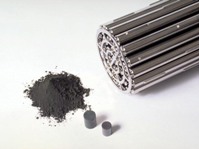The first re-use of nuclear fuel in a Candu reactor has started at Qinshan nuclear power plant in China.
 |
| Candu reactor fuel (Image: Cameco) |
If successful over a one-year trial, this practice could help China get more energy from its imported uranium and reduce stocks of highly-radioactive used nuclear fuel at the same time.
Mainstream light-water reactors, of which China has nine in operation, use uranium fuel enriched to 3-5% uranium-235. After spending around three years producing power in the reactor core the level of enrichment drops to nearer the natural level of about 0.7% and is removed. However, this fuel is still mostly composed of unaltered uranium capable of producing power in a pressurized heavy water reactor, like AECL's Candu model. Instead of using enriched fuel, these increase reactivity in the core by employing a heavy-water neutron reflector.
To make this first batch of NUE fuel, Qinshan managers collaborated with AECL, the Nuclear Power Institute of China and China North Nuclear Fuel Corporation. Fuel that had previously been used was processed to recover unspent uranium and this was mixed with some depleted uranium to achieve a mix with the same overall characteristics as natural uranium. Technical challenges in doing this included the highly-radioactive nature of the used fuel and achieving the right blend of depleted uranium and the recovered stocks still enriched up to around 1.6%.
The project to achieve this began in 2008, AECL said, to explore the idea and "prove that it is the simplest, most cost-effective and environmentally friendly process to utilize alternative fuel sources." A report late in 2009 suggested that China should build another two Candu reactors as part of a used fuel managment strategy.
A program in South Korea has pursued similar goals for some time. Dupic (Direct Use of PWR fuel in Candu) envisages the used fuel pellets from PWR fuel being broken up, heated to drive off radioactive fission products and then reformed for use in Candu fuel. Using Candu reactors in a similar way is also under investigation in Ukraine.
Progress in demonstrating this ability will be welcome at AECL, where hopes to export new-design reactors have faded in recent years. The company's plans to license its ACR-1000 design in the UK and USA are on hold and opportunities for new build in Canada have withered since the financial crisis. Meanwhile, the future of the state-owned corporation is uncertain as it approaches a major restructuring.
AECL's chief technology officer Anthony De Vuono said the NUE fuel cycle "opens up a sustainable development path leading to an overall extension of uranium fuel resources while, at the same time, reusing spent fuel from light water reactors."
Researched and written
by World Nuclear News




_18570.jpg)
_18938.jpg)
_33584.jpg)
_82983.jpg)





